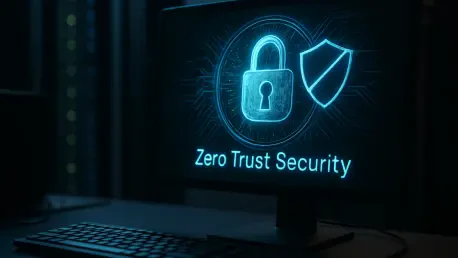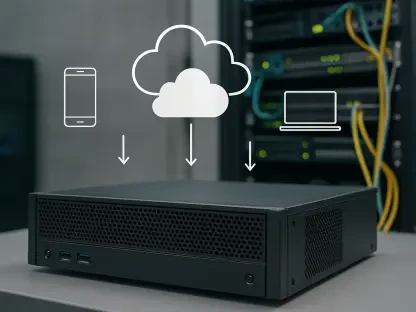In an era where cybersecurity threats evolve faster than ever, relying on traditional security models proves increasingly inadequate for protecting organizations’ digital assets. The rise of distributed workforces, cloud computing, and IoT devices demands a revolutionary approach to network security, known as Zero Trust. Fundamentally opposed to conventional perimeter defenses, Zero Trust operates on the principle of “never trust, always verify.” It assumes every attempt to access the network could potentially be malicious, irrespective of origin. Through this security framework, organizations aim to mitigate risks by continually authenticating and monitoring all network interactions, thus creating a more resilient defense strategy.
Transitioning from Traditional Security Models
Challenges of Conventional Perimeter-Based Security
Traditional network security structures often rely on perimeter-based defenses, essentially securing the gateway to the internal network much like a fortress. This method assumes threats primarily originate from external sources, leading to lower scrutiny and trust for entities already inside the network. However, with the widespread adoption of remote work and cloud resources, the boundaries that once defined these perimeters have blurred significantly. Advanced persistent threats (APTs) and supply chain attacks have demonstrated the fragility of static defenses, illustrating how malicious actors can exploit existing trust models to bypass security measures and cause significant harm.
The limitations of perimeter-based models have become particularly evident in today’s interconnected landscape. Maintaining a robust security posture requires more than safeguarding the network’s perimeters; it necessitates a paradigm shift towards continuous authentication and verification. As organizations incorporate more devices and users into their networks, the probability of unsecured endpoints and unauthorized access increases exponentially. This heightened risk environment underscores the urgent need for comprehensive solutions that can dynamically address evolving threat vectors, thus inspiring the adoption of Zero Trust architecture as a fundamental rebalancing of security priorities.
The Inception of the Zero Trust Framework
The Zero Trust model represents a transformative approach to cybersecurity, emphasizing identity-centric security over network location. By discarding implicit trust, Zero Trust mandates strict validation for all users, devices, and access requests. This model operates on the premise of least privilege, enabling only necessary access for performing specific tasks and preventing lateral movement within the network if a breach occurs. This segmentation not only provides a more granular level of security but also enhances overall network transparency, detection, and response capabilities.
Enterprises noting recurrent vulnerabilities in their perimeter defenses have increasingly turned to the Zero Trust architecture. The extensive verification process inherent in Zero Trust helps monitor user and device activity, allowing security teams to swiftly identify, isolate, and address potential threats before they escalate into significant incidents. As organizations implement Zero Trust principles, they often experience substantial reductions in the frequency and impact of data breaches, reinforcing the approach’s efficacy and viability as the go-to security paradigm.
The Ascension of Zero Trust in Modern Enterprises
The Fundamental Principles Underpinning Zero Trust
At the heart of Zero Trust lies a set of core principles that underpin its strategic success. Key among these is the principle of least privilege access, ensuring users and devices receive only the access necessary to complete their tasks, significantly reducing the attack surface. This principle extends to micro-segmentation within networks, a process that involves creating isolated segments, or zones, within an organization’s network. Such segmentation prevents unauthorized lateral movement, ensuring even if an attacker penetrates one zone, access to others remains restricted.
Another pillar of Zero Trust involves dynamic risk assessment and continual verification of every access request. Security protocols enforce identity-based authentication, constantly validating users’ and devices’ legitimacy. Continuous monitoring and risk assessment replace the outdated notion of a static security posture. Real-time visibility into network activities enhances the organization’s ability to detect anomalies and respond to threats efficiently, while significantly supporting compliance with regulatory frameworks.
SASE and Zero Trust: The Convergence of Cybersecurity Models
The Secure Access Service Edge (SASE) represents a contemporary model that encapsulates the principles of Zero Trust within its architecture. Combining the capabilities of SD-WAN, CASB, and firewall-as-a-service within a singular cloud-native platform, SASE efficiently delivers a holistic security solution. This unified approach reduces complexity, drives down operational costs, and standardizes security protocols across decentralized connections. As SASE frameworks integrate seamlessly with Zero Trust principles, they enhance an organization’s security efficacy, supporting distributed workforces and diverse cloud environments with comprehensive protection.
SASE’s native alignment with Zero Trust principles allows organizations to maintain consistency across sophisticated and polycentric network environments. Its framework ensures robust compliance, promotes heightened network visibility, and accommodates the dynamic nature of digital enterprise operations. Through its hybrid design, SASE strengthens security protocols by including continuous threat assessment, identity management, and least privilege enforcement. These factors collectively contribute to an elevated security posture, capable of combating rapidly evolving threats with precision and agility.
Integrating AI, Automation, and Identity-Centric Security
Leveraging AI and Automation for Enhanced Threat Detection
The integration of artificial intelligence and automation into security practices serves as a powerful countermeasure against increasingly complex cyber threats. Cybercriminals employ advanced technologies like AI to advance the sophistication of their tactics, necessitating equivalent enhancements in defensive strategies. AI-driven tools proficiently analyze massive volumes of network data, identifying anomalies that escape human detection capabilities. These systems enable organizations to establish baselines for normal behavior, flag deviations, and automatically trigger interventions when potential threats arise. Such intelligent automation allows for quicker response times, averting the progression of threats into larger security incidents.
Continuous improvements in AI and machine learning capabilities refine the accuracy of threat detection systems, making them an indispensable component in agile security frameworks. As these technologies evolve, they adapt to new threat patterns, increasing their efficacy in providing comprehensive network protection. Organizations benefit from the responsiveness and precision of AI-powered tools, integrating tightly with Zero Trust principles to create a robust defense mechanism that evolves in tandem with the threat landscape.
Importance of Identity-Centric Security Models
A pivotal shift from network-centric to identity-centric security models is underway, placing emphasis on the digital identity of both users and devices rather than their network location. This approach aligns seamlessly with Zero Trust objectives by enforcing stringent authentication and authorization protocols. Replacing traditional password mechanisms with multifactor identity verification enhances security and provides improved oversight over access activities. Continuous real-time authentication ensures compliance with Zero Trust’s imperative for ongoing validation, equipping organizations with comprehensive visibility into user behaviors and potential threat vectors.
Identity-centric models empower organizations with deeper insights into who accesses their networks, how resources are utilized, and where potential noncompliance occurs. This level of scrutiny enriches the overall security framework, resulting in a strategic advantage against cyber adversaries. By focusing on confirming the legitimacy and context of access requests, organizations cultivate an empowering security posture, effectively safeguarding sensitive assets and minimizing the risk of unauthorized intrusions.
Network Visibility and Executive Governance
Enriching Insights Through Comprehensive Network Visibility
Comprehensive network visibility stands at the forefront of effective Zero Trust implementation, as it facilitates the discernment of legitimate and anomalous activities. Prompt detection and analysis of these activities provide vital insights into potential threats, aiding in the prevention of major security breaches. Events such as the SolarWinds and Colonial Pipeline ransomware attacks underscore the necessity for organizations to maintain high levels of network visibility. Effective threat management increasingly depends on the ability to observe, analyze, and contextualize network interactions to unearth security incidents proactively.
Incorporating sophisticated visualization tools into security architectures enables organizations to transform raw data into actionable insights. This capability allows security teams to pinpoint vulnerabilities, analyze threat patterns, and evaluate the effectiveness of implemented security measures. By leveraging tools that convert technical details into tangible, business-oriented insights, leadership can make informed strategic decisions, shaping a modern security strategy that aligns with broader business objectives.
Elevating Executive Roles in Cybersecurity Strategies
As the landscape of cybersecurity evolves, executive leadership plays an increasingly crucial role in steering its course. Essential security insights must be readily accessible to executives, enabling informed decision-making and swift action against emerging threats. Traditional models emphasizing periodic evaluations and report updates are being replaced by dynamic systems that offer real-time access to comprehensive security data. Executive dashboards highlighting key metrics allow leaders to swiftly assess the organization’s cybersecurity resilience and adapt strategies accordingly.
With cybersecurity emerging as a business imperative beyond its technical roots, executives shoulder the responsibility of integrating robust, forward-looking security approaches into broader organizational strategies. This evolution demands tools and processes that communicate complex security realities efficiently. By ensuring alignment between security objectives and business goals, executive-driven initiatives enhance the overall security posture and prepare the organization for the challenges posed by an ever-changing cyber threat landscape.
Strategic Implementation and Future Considerations
In today’s rapidly evolving digital landscape, cybersecurity threats are advancing at an unprecedented pace, rendering traditional security measures insufficient for safeguarding an organization’s digital assets. The shift towards a distributed workforce, coupled with the widespread adoption of cloud computing and IoT devices, necessitates a groundbreaking shift in how we approach network security. This is where the Zero Trust model comes into play. Unlike conventional perimeter-based security defenses, Zero Trust operates on the foundational principle of “never trust, always verify.” This means that every request to access the network is treated as a potential threat, regardless of where it originates. By continuously verifying and authenticating all network interactions, the Zero Trust framework aims to reduce vulnerabilities and enhance security. This approach not only strengthens the organization’s defensive posture but also ensures that only verified users and devices gain access to sensitive data. In essence, adopting a Zero Trust model is about assuming that threats are omnipresent and acting proactively to address them. By implementing this model, organizations can better protect their data, maintaining a security stance that adapts to the ever-changing threat landscape while fostering a culture of vigilance and resilience in the face of cyber threats.









